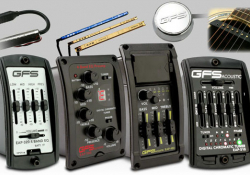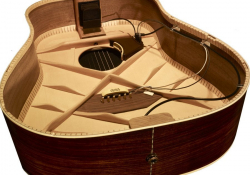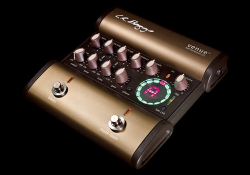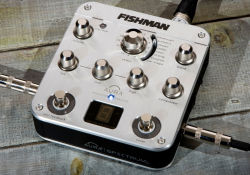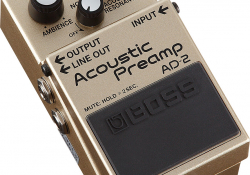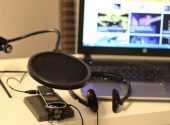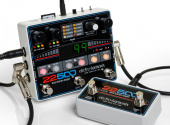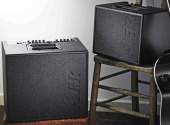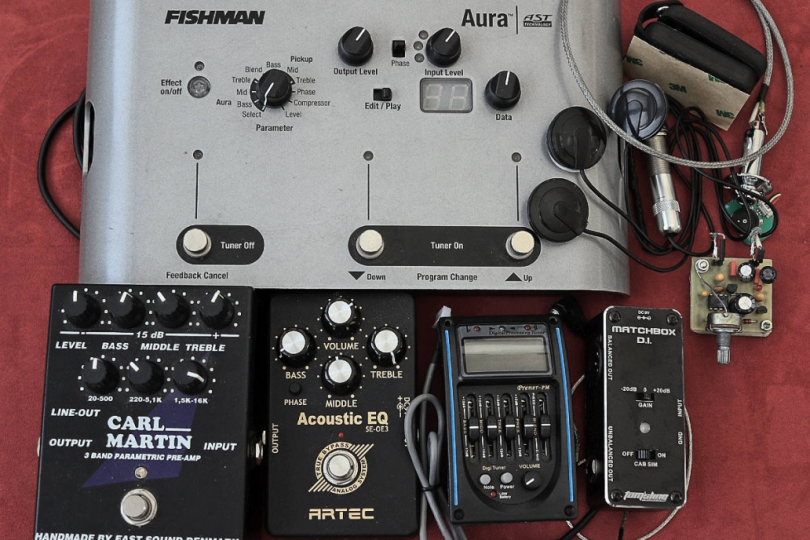
The Handbook for Electro Acoustic Guitarists, Chapter 5: Preamps
A very important part of the acoustic guitar sound system is the preamplifier or preamp. We've touched on them lightly in the previous parts of this series, but now we'll discuss them in more detail, including further context.
What is a preamp and why do we need one? It is simply an electronic circuit that amplifies the relatively weak output of pickups. This prevents noise, cable losses and brings the signal volume to a desired level that is easier to work with further down the line. In the chapter 1 I stated that the bare minimum for sound is a pickup, which is of course true, but if you make it easier for the sound engineer by adding a preamp (or more of them), they'll like you a lot better. In fact, nowadays a simple preamp is usually included in a kit with a pickup, so we should have the first piece by now. Passive pickups are more rarely found nowadays, except that they don't need their own power supply, that's the end of their advantages. That's why we will first focus on active preamps, usually powered by a 9V battery.
Onboard preamps
The first and most numerous group – they are assembled as part of the guitar in three basic ways.
The least intrusive on the guitar are the so-called end pin preamps, which are part of the output jack. The eternal debate is about the placement of the battery needed (some end pin preamps tend to be powered by button cell batteries). Various battery cases are used, either glued inside the guitar or as part of the output jack, which I would personally recommend for ease of battery replacement as well as uncompromising fit. I've had a few complications with gluing using various velcro straps falling off, not to mention having to blindly handle the batteries inside the guitar with dropped strings. Fortunately, the power consumption of the preamps is very low, so if you don't forget the cord plugged in the guitar, the battery will last safely for many months.
They are sometimes supplemented by simple rotary volume or tone pots glued to the underside of the soundboard, so that they can be reached through the soundhole and no more holes have to be drilled in the guitar. These knobs are lightweight and the danger of them coming off is minimal, unlike a heavier battery with more inertia during movement. On stage, it is useful to have at least volume or mute available, or to have this solved by an external pedal.
Tip: If you don't want to completely drop the strings, loosen them and put on a capo. Then just pull the pegs and strings out of the bridge. This gives you free access to the sound hole, but the strings won't get tangled and overall handling is much faster.
Next are preamps mounted directly into the sides of the guitar. Although they need a fairly large "hole in the guitar", I personally prefer them because they offer so many more options. They are usually equipped with a basic equalizer, a tuner, a mixing ratio of different pickups (blend), a rephasing or a notch filter (against feedback). This allows you to react to specific and often unexpected situations on stage (too much bass, different volume, feedback, etc.). There is a plethora of them on the market and everyone can choose according to their personal requirements.
People are often afraid of irreversible intervention in the guitar. That's why I reiterate that I would consider fitting rare expensive guitars, but I wouldn't hesitate to fit working instruments that are meant to be used on stage. Despite the flood of warning messages from all sorts of internet smartasses, there is no sonic deterioration (at most, on a psycho-acoustic level) when professionally installed, and the only harm may be the collector's value. Anyway, I too once succumbed and had one custom guitar built so that the sides were minimally loaded, the power was a stereo cord from a special rack preamp... and after a while I had it rebuilt in a more conventional way – and I didn't notice any sonic deterioration, only the benefits of far more operative control.
The last, and increasingly expanding, group are preamps glued to the underside of the soundboard with the drivers on the edge of the soundhole. These are again lightweight and with a large adhesive surface, making installation safe. They are sought after by those who don't want to cut extra holes in their guitar. For example, the celebrated LR Baggs Anthem is offered in all three of the above-mentioned options and you can choose what suits you best.
Of course, there are other ways, such as the Taylor expression system, or the Mi-Si with battery-free usb flash power, but the purpose of this series is to give you a basic orientation to the subject and not to overwhelm you with an encyclopedic deluge of details, because there's still plenty to come anyway.
External (outboard) preamps
These do the same things as internal preamps, but due to lack of space constraints they can (and do) offer many more options. In fact, it is logical to combine many functions at once in them, so there are large subsets of all sorts of crossovers, especially with effects. Of course, the basic function, i.e. signal amplification, still remains, and in the case of simpler boxes, it is conveniently supplemented with, for example, an equalizer, a frequency booster for solos or a feedback limiter. In more sophisticated products, there can be much more.
Because the acoustic segment has not been nearly as full as it is today, it was common to use preamps designed for basses, which you don't have to be afraid of even today. Fortunately, there's no need to make rocket science out of it because it's really just about amplification without noise and distortion – and in that, all preamps are similar in principle.
Since the awareness of them is not so publicly known and their search and filtering without keywords is not always clear, I offer here a few more tips on products proven by years of practice:
L.R. Baggs Para Acoustic DI Preamp, L.R. Baggs Venue DI Acoustic Preamp, Fishman Platinum Stage EQ/DI, Fishman Aura Spectrum DI, Radial Tonebone PZ-Pre, Boss AD-8, Boss AD-2, Headway EDB-2 Acoustic Preamp, Headway EDM-1 Acoustic Preamp, Zoom A3, BBE Acoustimax… Recently, even famous manufacturers of amplifiers for electric guitars have jumped headfirst into this previously godforsaken segment, so nowadays even a "folkish guitarists" can buy a mythical "boogie" or a hipster "orange".
The right question is why I should use an external box if there is a preamp in my guitar. In addition to the expanded sound and control options, another crossover is hidden in the codename DI or direct input, and preamps are almost always crossed with a so-called DI box. However, that's getting into other areas associated with other acronym terms such as impedance, balanced output, XLR, guitar cable types and many more. Gradually, it may be time to make the next part a bit more explanatory and summarizing, as an acupedia would do.
If you have found an error or typo in the article, please let us know by e-mail info@insounder.org.


